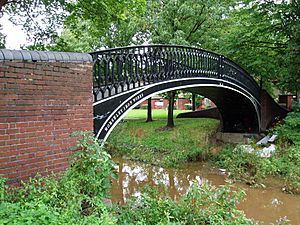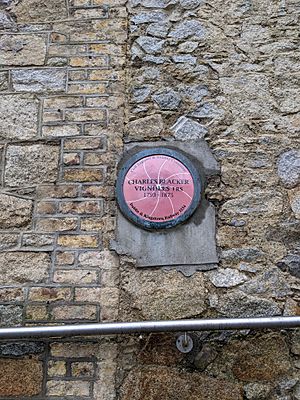Charles Blacker Vignoles facts for kids
Quick facts for kids
Charles Blacker Vignoles
|
|
|---|---|
 |
|
| Born | 31 May 1793 County Wexford, Ireland
|
| Died | 17 November 1875 (aged 82) |
| Nationality | British |
| Occupation | Engineer |
| Engineering career | |
| Discipline | civil engineer |
| Institutions | Institution of Civil Engineers (president) |
| Significant design | Vignoles rail |
| Signature | |
 |
|
Charles Blacker Vignoles (born May 31, 1793 – died November 17, 1875) was a very important British engineer. He helped build many early railways. He is also famous for a special type of railway track called the Vignoles rail.
Contents
Early Life and Education
Charles Blacker Vignoles was born in May 1793 in County Wexford, Ireland. When he was just a baby, his parents, Captain Charles Henry Vignoles and Camilla, sadly died from yellow fever in the West Indies.
Young Charles, only 13 months old, was cared for by a kind merchant. Later, his uncle, Captain George Henry Hutton, brought him to England. Charles was then raised by his grandfather, Charles Hutton. His grandfather was a Professor of Mathematics at the Royal Military Academy, Woolwich.
Charles learned a lot about mathematics and law. He decided not to become a lawyer and left home in 1813 to find other work.
Army Adventures
Because his father was an army officer, Charles was made an ensign (a junior officer) when he was very young. He later went to Sandhurst.
In 1814, Charles joined the Royal Scots regiment. He served in battles like the siege of Bergen op Zoom. He also served in Canada. In 1815, he became a lieutenant. After some time in Scotland, he worked as an aide-de-camp (a personal assistant) for Major-General Sir Thomas Brisbane. They served under the famous Duke of Wellington.
When the war ended in 1816, Charles was put on half-pay. This meant he received less money. He looked for other jobs, but he didn't officially leave the army until 1833.
Family Life
Charles married Mary Griffiths in England on July 13, 1817. They had five children together. Three of their sons, Charles Francis Fernando, Hutton, and Henry, also became engineers.
Another son, Olinthus John Vignoles, became a minister in the Church of England. He wrote a book about his father's life. This book shared many stories about the early days of railways.
Charles Blacker Vignoles's great-great-grandson is the famous pianist, Roger Vignoles.
Working in America
After leaving the army, Charles sailed to America. He first worked as an assistant civil engineer in Charleston, South Carolina.
In 1821, he became the city surveyor for St Augustine, Florida. He helped plan how the city would grow. In 1823, he created an important map of Florida. He also wrote a book called Observations on the Floridas.
Charles faced some money problems. In 1823, he returned to Britain after his grandfather passed away.
Railway Engineering Projects
Early Railway Work (1820s)
Back in England, Charles found work as a surveyor. He also wrote articles for a large encyclopedia. He then opened his own engineering office.
In 1825, Charles was asked to survey (or map out) routes for new railways. These included the proposed London and Brighton Railway. He also worked on the first surveys for the Liverpool and Manchester Railway. This was after an earlier plan for the railway was rejected.
Charles and his family moved to Liverpool. His skills in surveying and law helped him explain the need for new railway lines in Parliament.
However, Charles had a disagreement with George Stephenson, another famous railway engineer. Charles resigned from the Liverpool and Manchester Railway project in 1827.
Later, Marc Isambard Brunel offered Charles a job on the Thames Tunnel. But Brunel gave the job to his own son, Isambard Kingdom Brunel, instead. Charles continued to work on other railway lines. These included the Wigan Branch Railway (1832) and the St Helens and Runcorn Gap Railway (1833). The St Helens railway was one of the first to use a bridge to cross another railway line, instead of a flat crossing.
In 1829, Charles helped with a famous steam locomotive called the Novelty. This was for the Rainhill Trials, a competition to find the best locomotive. He also worked with John Ericsson to invent a way for trains to climb steep hills.
Expanding Railways (1830s)
Charles's experience led to bigger projects. He worked on new railways in Ireland. This included Ireland's very first railway, the Dublin and Kingstown Railway (1832–34).
He also designed the "Vignoles Bridge" in Coventry in 1835. This bridge originally crossed the Oxford Canal.
In 1835, he surveyed the route for the Sheffield, Ashton-Under-Lyne and Manchester Railway. This project included the original Woodhead Tunnel. Charles even experimented with a steam boring machine for this tunnel. However, he left the project before work began due to disagreements.
He also surveyed the Midland Counties Railway. This line connected the cities of Nottingham, Derby, and Leicester with Rugby. It opened in 1839.
International Projects (1840s)
The early 1840s were a bit tough for Charles. He became a professor of civil engineering at University College, London. He also supported and built atmospheric railways, which used air pressure to move trains.
His luck improved with the "Railway Mania" between 1844 and 1846. This was a time when many new railways were being planned and built.
In 1846, he was hired to build the Nicholas Chain Bridge in Kiev, over the Dnieper River. Kiev was then part of the Russian Empire, and is now in Ukraine. This bridge was built from 1847 to 1853. It was half a mile long and, at the time, the largest of its kind in Europe. Charles lived in Ukraine during this time, but often returned to England.
His first wife, Mary, had passed away in 1834. In 1849, he married Margaret Hodge.
More Global Work (1850s)
After his time in Ukraine, Charles worked on some projects in England, like the London, Chatham and Dover Railway. But most of his work was in other countries. He helped build railways like the Frankfurt, Wiesbaden, and Cologne Railway and the Western Railway in Switzerland.
He also worked on railways in the Duchy of Nassau (now part of Germany). Between 1857 and 1864, he was the engineer for the Tudela & Bilbao Railway in Spain. Finally, in 1860, he worked on the Bahia and San Francisco Railway in Brazil.
Later Life
Charles Vignoles retired in 1863. He moved to Hythe, near Southampton, in 1867.
He suffered a stroke after a visit to London and passed away on November 17, 1875. He was buried in Brompton Cemetery, London.
The Vignoles Rail
In 1836, Charles suggested using a special type of flat-bottomed rail for the London and Croydon Railway. This type of rail was first invented by an American named Robert Livingston Stevens in 1830. However, Charles's name became strongly connected with it, and it is now known as the Vignoles rail.
This rail became very popular in Europe. But it was not widely used in Britain and Ireland until the 20th century.
Legacy and Achievements
Charles Blacker Vignoles achieved many important things:
- He became a member of the Institution of Civil Engineers in 1827. He later became its 15th President in 1869.
- He was elected a fellow of the Royal Astronomical Society in 1829.
- In 1841, he became the first Professor of Civil Engineering at University College, London.
- In 1855, he was elected as a Fellow of the Royal Society. This is a very high honor for scientists.
- He was a founding member of the Photographic Society of London.
- He also served on a royal commission for the Ordnance Survey (which makes maps). He was connected with the Royal Irish Academy and the Royal Institution.
See also
In Spanish: Charles Blacker Vignoles para niños




